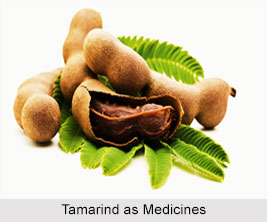 Tamarind is a very well known herb having many uses such as culinary, medicinal, ornamental uses and as an economic dye. Its botanical name is Tamarindus Indica. The tamarind tree is met with throughout India, and has been known from a very remote period. Tamarinds form an important ingredient in native cookery. The unripe fruit is very acid and possesses a peculiar aroma for which it is much relished when cooked with curry.
Tamarind is a very well known herb having many uses such as culinary, medicinal, ornamental uses and as an economic dye. Its botanical name is Tamarindus Indica. The tamarind tree is met with throughout India, and has been known from a very remote period. Tamarinds form an important ingredient in native cookery. The unripe fruit is very acid and possesses a peculiar aroma for which it is much relished when cooked with curry.
Health Benefits of Tamarind
The ripe fruit is regarded as refrigerant, digestive, carminative and laxative, and useful in diseases supposed to be caused by deranged bile, such as burning of the body, costiveness, intoxication from spirituous liquors or datura, etc.
Dose of Tamarind in Medicine
The shells of the ripe fruit are burnt, and their ashes used in ancient medicine as an alkaline substance, along with other medicines of the sort, as for example in the preparation called "Abhayalavana". The pulp of the ripe fruit, as well as a poultice of the leaves, is recommended to be applied to inflammatory swellings.
Amlika Pana: Macerate some tamarind pulp in water; strain and add black pepper, sugar, cloves, camphor and cardamoms to taste. This preparation is prescribed as an agreeable cooling draught in loss of appetite and disinclination for food.
In intoxication from spirituous liquors the following mixture is recommended by Chakradatta; take dates, raisins, tamarind pulp, pomegranate seeds, fruits of Grewia Asiatica (Parushaka) and ripe emblic myrobalans each one tola, pound them together and make an emulsion with 32 tolas of water. Dose is about 2 ounces.
This article is a stub. You can enrich by adding more information to it. Send your Write Up to content@indianetzone.com
Related Articles
Ayurveda
Origin of Ayurveda
Ayurveda Medication
Elements of Ayurveda
Concepts of Ayurveda
Ancient Literature of Ayurveda





